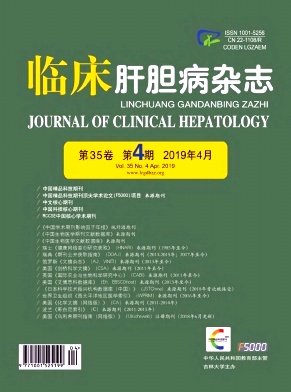|
[1]BRENNER DA, PAIK YH, SCHNABL B. Role of gut microbiota in liver disease[J]. J Clin Gastroenterol, 2015, 49 (Suppl 1) :s25-s27.
|
|
[2]ZHANG Y, FENG Y, CAO B, et al. The effect of small intestinal bacterial overgrowth on minimal hepatic encephalopathy in patients with cirrhosis[J]. Arch Med Sci, 2016, 12 (3) :592-596.
|
|
[3]PURI P, SANYAL AJ. The intestinal microbiome in nonalcoholic fatty liver disease[J]. Clin Liver Dis, 2018, 22 (1) :121-132.
|
|
[4]BORRELLI A, BONELLI P, TUCCILLO FM, et al. Role of gut microbiota and oxidative stress in the progression of non-alcoholic fatty liver disease to hepatocarcinoma:Current and innovative therapeutic approaches[J]. Redox Biol, 2018, 15:467-479.
|
|
[5]SHAH A, SHANAHAN E, MACDONALD GA, et al. Systematic review and meta-analysis:Prevalence of small intestinal bacterial overgrowth in chronic liver disease[J]. Semin Liver Dis, 2017, 37 (4) :388-400.
|
|
[6]KONG L, LU Y, ZHANG S, et al. Role of nutrition, gene polymorphism, and gut microbiota in non-alcoholic fatty liver disease[J]. Discov Med, 2017, 24 (131) :95-106.
|
|
[7]LI W, ZHANGK, YANG H. Pectin alleviates high fat (lard) Diet-induced nonalcoholic fatty liver disease in mice:Possible role of short-chain fatty acids and gut microbiota regulated by pectin[J]. J Agric Food Chem, 2018, 66 (30) :8015-8025.
|
|
[8]ALTAMIRANO-BARRERA A, URIBE M, CHAVEZ-TAPIA NC, et al. The role of the gut microbiota in the pathology and prevention of liver disease[J]. J Nutr Biochem, 2018, 60:1-8.
|
|
[9]ZHU L, BAKER RD, BAKER SS. Gut microbiome and nonalcoholic fatty liver diseases[J]. Pediatr Res, 2015, 77 (1-2) :245-251.
|
|
[10]CAHOVA M, BRATOVA M, WOHL P. Parenteral nutrition-associated liver disease:The tole of the gut microbiota[J]. Nutrients, 2017, 9 (9) :987.
|
|
[11]WIEST R, LAWSON M, GEUKING M. Pathological bacterial translocation in liver cirrhosis[J]. J Hepatol, 2014, 60 (1) :197-209.
|
|
[12]DAVIS BC, BAJAJ JS. The human gut microbiome in liver diseases[J]. Semin Liver Dis, 2017, 37 (2) :128-140.
|
|
[13]TILG H, CANI PD, MAYER EA. Gut microbiome and liver diseases[J]. Gut, 2016, 65 (12) :2035-2044.
|
|
[14]WEN Z, JI X, TANG J, et al. Positive feedback regulation between transglutaminase 2 and Toll-Like receptor 4 signaling in hepatic stellate cells correlates with liver fibrosis post schistosoma japonicum Infection[J]. Front Immunol, 2017, 8:1808.
|
|
[15]YAN C, LI B, FAN F, et al. The roles of Toll-like receptor 4 in the pathogenesis of pathogen-associated biliary fibrosis caused by Clonorchis sinensis[J]. Sci Rep, 2017, 7 (1) :3909.
|
|
[16]KANG HH, KIM IK, LEE HI, et al. Chronic intermittent hypoxia induces liver fibrosis in mice with diet-induced obesity via TLR4/MyD88/MAPK/NF-kB signaling pathways[J]. Biochem Biophys Res Commun, 2017, 490 (2) :349-355.
|
|
[17]KUMAR S, WANG J, SHANMUKHAPPA SK, et al. Toll-Like receptor 4-independent carbon tetrachloride-induced fibrosis and lipopolysaccharide-induced acute liver injury in mice:role of hepatic stellate cells[J]. Am J Pathol, 2017, 187 (6) :1356-1367.
|
|
[18]GOMEZ-HURTADO I, SUCH J, FRANCES R. Microbiome and bacterial translocation in cirrhosis[J]. Gastroenterol Hepatol, 2016, 39 (10) :687-696.
|
|
[19]BAJAJ JS, BETRAPALLY NS, GILLEVET PM. Decompensated cirrhosis and microbiome interpretation[J]. Nature, 2015, 525 (7569) :e1-e2.
|
|
[20]SINGH A, CRESCI GA, KIRBY DF. Proton pump inhibitors:Risks and rewards and emerging consequences to the gut microbiome[J]. Nutr Clin Pract, 2018, 33 (5) :614-624.
|
|
[21]Chinese Society of Hepatology, Chinese Medical Association.Guidelines on the management of hepatic encephalopathy in cirrhosis[J/CD]. Chin J Liver Dis:Electronic Edition, 2018, 10 (4) :17-32. (in Chinese) 中华医学会肝病学分会.肝硬化肝性脑病诊疗指南[J/CD].中国肝脏病杂志:电子版, 2018, 10 (4) :17-32.
|
|
[22]YILDIZ S, DOGAN I·, DOGRUMAN-Al F, et al. Association of enteric protist blastocystis spp and gut microbiota with hepatic encephalopathy[J]. J Gastrointestin Liver Dis, 2016, 25 (4) :489-497.
|
|
[23]LACHAR J, BAJAJ JS. Changes in the microbiome in cirrhosis and relationship to complications:Hepatic encephalopathy, spontaneous bacterial peritonitis, and sepsis[J]. Semin Liver Dis, 2016, 36 (4) :327-330.
|
|
[24]ACHARYA C, BAJAJ JS. Gut microbiota and complications of liver disease[J]. Gastroenterol Clin North Am, 2017, 46 (1) :155-169.
|
|
[25]SANTIAGO A, POZUELO M, POCA M, et al. Alteration of the serum microbiome composition in cirrhotic patients with ascites[J]. Sci Rep, 2016, 6:25001.
|
|
[26]AITBAEV KA, MURKAMILOV IT, FOMIN VV. Liver diseases:The pathogenetic role of the gut microbiome and the potential of treatment for its modulation[J]. Ter Arkh, 2017, 89 (8) :120-128.
|
|
[27]ZAPATER P, GONZALEZ-NAVAGAS JM, SUCH J, et al. Immunomodulating effects of antibiotics used in the prophylaxis of bacterial infections in advanced cirrhosis[J]. World J Gastroenterol, 2015, 21 (41) :11493-11501.
|
|
[28]PONZIANI FR, GERARDI V, PECERE S, et al. Effect of rifaximin on gut microbiota composition in advanced liver disease and its complications[J]. World J Gastroenterol, 2015, 21 (43) :12322-12333.
|
|
[29]GOMEZ-HURTADO I, GIMENEZ P, GARCIA I, et al. Norfloxacin is more effective than Rifaximin in avoiding bacterial translocation in an animal model of cirrhosis[J]. Liver Int, 2018, 38 (2) :295-302.
|
|
[30]SARANGI AN, GOEL A, SINGH A, et al. Faecal bacterial microbiota in patients with cirrhosis and the effect of lactulose administration[J]. BMC Gastroenterol, 2017, 17 (1) :125.
|
|
[31]SUN YP, GUO XX. Clinical effect of probiotics in treatment of liver cirrhosis:A meta-analysis[J]. J Clin Hepatol, 2018, 34 (1) :73-79. (in Chinese) 孙元培, 郭晓霞.微生态制剂治疗肝硬化的Meta分析[J].临床肝胆病杂志, 2018, 34 (1) :73-79.
|
|
[32]LIU J, FU UY, ZHANG H, et al. The hepatoprotective effect of the probiotic Clostridium butyricum against carbon tetrachloride-induced acute liver damage in mice[J]. Food Funct, 2017, 8 (11) :4042-4052.
|
|
[33]LAVEKAR AS, RAJE DV, MANOHAR T, et al. Role of probiotics in the treatment of nonalcoholic fatty liver disease:A meta-analysis[J]. Euroasian J Hepatogastroenterol, 2017, 7 (2) :130-137.
|







 DownLoad:
DownLoad: